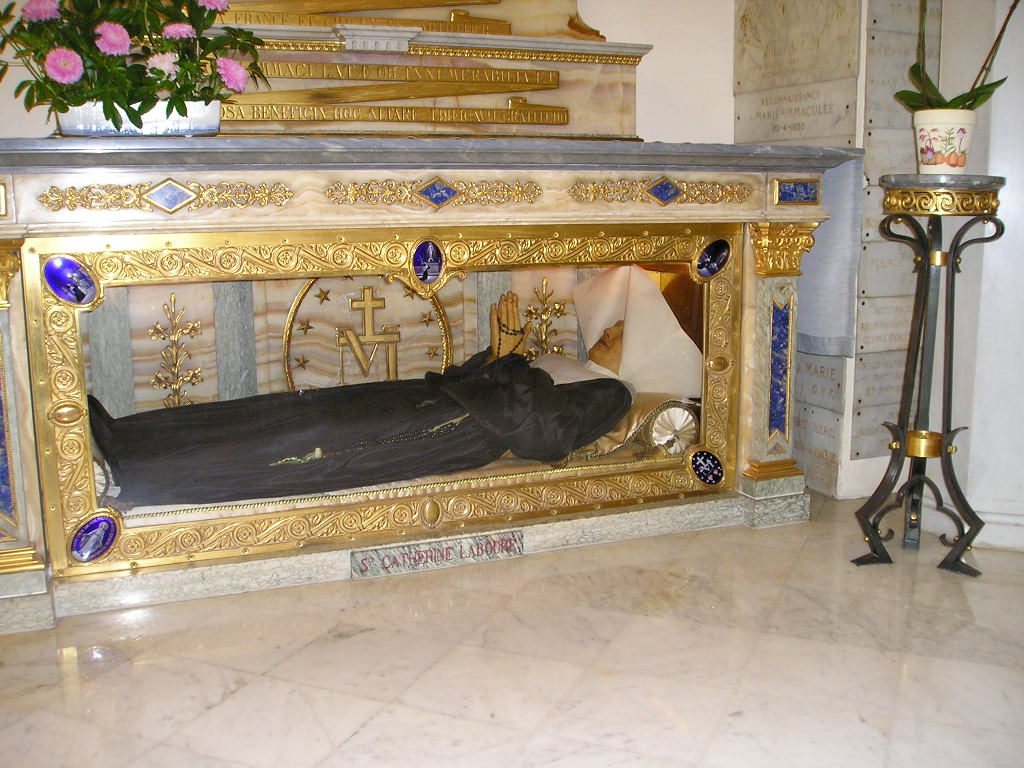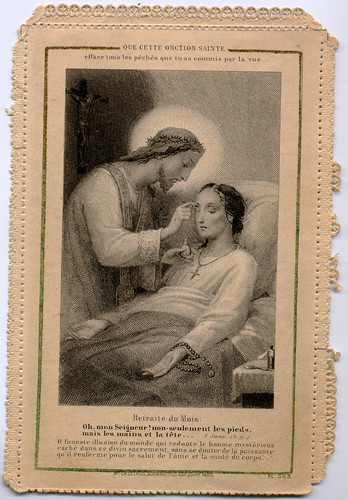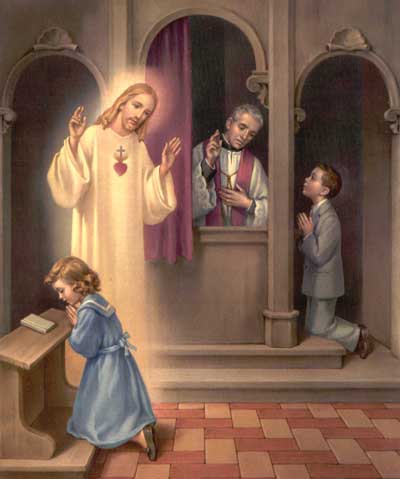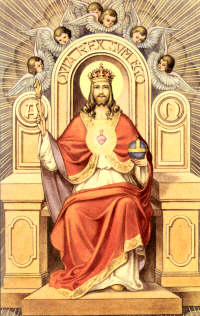The front side of the Medal: messages and symbolism
On the front side of the medal we see the Blessed Virgin Mary as the Victorious Woman of Genesis. God Himself put enmities between the Woman and the serpent, a battle to be carried on "in that ‘monumental struggle against the powers of darkness’ which continues throughout human history." (Mother of the Redeemer, #47, p.67; Pope John Paul II; March 25, 1987)
On the medal we see Mary Immaculate with her foot crushing the head of the serpent. "She who as the one ‘Full of Grace’ was brought into the Mystery of Christ in order to be His Mother and thus the Holy Mother of God . . . remains in that mystery as ‘the Woman’ spoken of by the Book of Genesis (3:15) at the beginning . . . " (Mother of the Redeemer, #24, p.23; Pope John Paul II; March 25, 1987). In many other official documents of the Church and writings of Saints we find Mary referred to as this Victorious Woman of Genesis destined to crush the proud head of the devil.
"The Bible is replete with the mystery of the Savior, and from Genesis to the Book of Revelation, also contains clear references to her who was the Mother and Associate of the Savior." (Marialis Cultus, #30, p.28; Pope Paul VI; Feb.2, 1974).
The year 1830 was shown inscribed on the globe at the base of the Medal, so it is clearly meant to convey some message. It can very well indicate the year which begins the final stages of the battle between the Woman and the serpent, between good and evil. It could be Heaven’s way of indicated the year opening the Marian Era.
Our Lady is standing on the globe of the world. Catherine could distinguish France in particular. In this we can see Mary both as the Victorious Woman and as the Queen of Heaven and Earth.
Mary’s hands are shown showering a cascade of brilliant rays on the world, as if she found them too heavy with graces and was eager to pour them on us. We can see her as our "Advocate, Auxiliatrix, Adjutrix and Mediatrix. Of this intercession of hers for the People of God with the Son, the Church has been persuaded ever since the first centuries . . . " (The Great Sign, Part I, p.4; Pope Paul VI; May 13, 1967).
Around the oval frame of the medal we read the words, "O Mary, conceived without sin, pray for us who have recourse to you." In this brief prayer we find the truth of (a) the Immaculate Conception of Mary, and (b) Mary’s intercessory power with God for us who ask for her aid.
The reverse side of the Medal
On the reverse side of the Medal we see a Cross, the symbol of Christ’s Redeeming Sacrifice on Mount Calvary for the salvation of the world.
At the base of the Cross is a bar, which symbolizes the foot of the Cross. Intertwined with the bar is the letter "M" symbolizing the Mary’s intimate involvement at the foot of the Cross with her Son’s Redemptive Sacrifice. We see the "M" is below the line or foot of the Cross, signifying Mary’s subordinate role to that of Jesus. "This union of the Mother and her Son in the work of Redemption (cf. Lumen Gentium, #57) reaches its climax on Calvary, where Christ ‘offered Himself as the perfect Sacrifice to God’ (Hebrew 9:14), and where Mary stood by the Cross (cf. John 19:25), ‘suffering grievously with her only-begotten Son. There she united herself with a maternal Heart to His Sacrifice, and lovingly consented to the immolation of this Victim which she herself had brought forth’ (II Vatican Council, Dogmatic Constitution on the Church Lumen Gentium, #58), and also was offering to the Eternal Father." (Marialis Cultus, #20, p.19, Pope Paul VI, Feb.2, 1974)
It was also at the foot of the Cross that Jesus gave us, in the person of the Beloved Disciple, His own Mother to be our Mother. "Woman, behold your son; son, behold your Mother" (John 19, 25-27). And the beloved disciple gives us an example to follow, so that we learn to take Mary into our homes, into our lives, into our hearts, as do loving children.
So the "M" stands not only for Mary, but also for Mother. "The new Motherhood of Mary, generated by faith, is the fruit of the ‘new’ love which came to definite maturity in her at the foot of the Cross, through her sharing in the Redemptive Love of her Son. Thus we find ourselves at the very center of the fulfilment of the promise contained in the Proto-gospel . . . (Gen. 3:15)" (Mother of the Redeemer, #23-24; p.33; Pope John Paul II; March 25, 1987). "Mary’s mediation is intimately linked with her Motherhood." (ib. #39; p.54)
Since the Cross is the symbol of Christ’s Redemptive Sacrifice, we can also see a Eucharistic symbolism on the Medal. "To perpetuate down the centuries the Sacrifice of the Cross, the Divine Savior instituted the Eucharistic Sacrifice [the Mass], the Memorial of His Death and Resurrection, and entrusted it to His Spouse the Church" (cf. II Vatican Council, Sacrosanctum Concilium, #47), which the Church continues to do "in union with the Saints in Heaven, and in particular with the Blessed Virgin." (Marialis Cultus, #20, p.19-20; Pope Paul VI; Feb. 2, 1974). In every Eucharistic Liturgy the Church involves the Blessed Virgin Mary, so befitting to her who stood heroically at the foot of the Cross uniting her sufferings to the Sacrifice of her Son, filling up in her body those things that are wanting to the sufferings of Christ, for the sake of His Mystical Body, the Church. (cf. Col. 1:24). In all of the approved apparitions of Our Lady there is a Eucharistic thrust. She usually asked for a church to be built, in which the Eucharistic Sacrifice and the Blessed Sacrament always have prime place. Mary always leads us to Jesus, and Jesus is especially present in the Eucharist.
On the Medal beneath the Cross and the "M" we see the two Hearts, the Sacred Heart of Jesus encircled with a crown of thorns, and the Immaculate Heart of Mary pierced with a sword. We see the prophesy of Holy Simeon fulfilled: the Son who was destined for the sign of contradiction, dying on the Cross, and the Mother pierced with a sword of sorrow beneath the Cross "so that the thoughts of many hearts may be revealed" (Luke 2, 34-35). The union of the two Hearts foreshadows the message of Fatima: "The Sacred Heart of Jesus wants the Immaculate Heart of Mary to be venerated at His side." (Lucia Speaks, III Memoir, World Apostolate of Fatima, Washington, NJ: 1976; p.137). "God wishes to establish in the world devotion to my Immaculate Heart." (ib. p.126)
The two Hearts are surmounted by flames, symbolizing the burning love with which Jesus and Mary accomplished the work of Redemption, each in their proper way. No greater love does one have than to lay down one’s life. (cf. John 15:13). "Christ loved the Church and gave Himself up for her . . . " (Ephesus 5:25-27)
Around the oval frame of the Medal, encircling the Cross, the "M," and the two Hearts, we see a crown of twelve stars. This can be seen as a reference to the "the Great Sign" in the Book of Revelation/Apocalypse; the "Woman clothed with the sun, with the moon beneath her feet, and on her head a crown of twelve stars." The Woman engaged in battle with the "huge red Dragon . . . the ancient serpent, who is called the devil, or Satan" (Rev./Apoc. 12:3 & 9) is the Queen of the Apostles, the Mother of the Church. "The enmity, foretold at the beginning, is confirmed in the Apocalypse (the book of the final events of the Church and the world), in which there recurs the sign of the ‘Woman,’ this time ‘clothed with the sun’ (Rev. 12:1). Mary, Mother of the Incarnate Word, is placed at the very center of that enmity, that struggle which accompanies the history of humanity on earth and the history of Salvation itself." (Mother of the Redeemer, #11; p.16; Pope Johne Paul II, March 25, 1987)
We can see then in the Miraculous Medal a symbol of the whole history of salvation from Genesis to Apocalypse, and we can see the vital role that the Victorious Woman is destined in the final defeat of the devil. It is amazing how in such a small medal God can give us so many profound lessons. As is the case with all of God’s graces, it is up to us to humbly accept what He offers, as Mary did (cf. Luke 1:38), and to cherish and ponder it in our hearts, as Mary did. (cf. Luke 2:19 & 51)
(Courtesy Here)


















